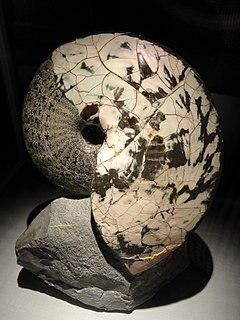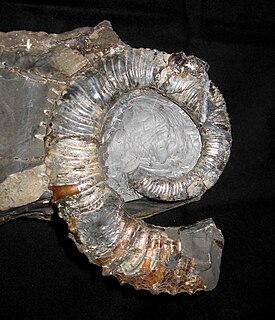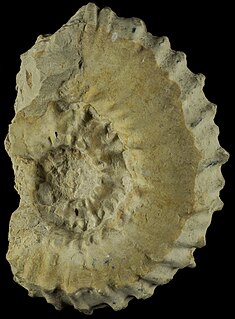Kamerunoceras is an extinct cephalopod genus belonging to the ammonite family Acanthoceratidae, found in Upper Cretaceous formations of Africa, Europe and North and South America.
Astiericeras is an ammonite from the Lower Cretaceous, the shell of which is evolute, stout; outer whorl with strong, well spaced, transverse ribs that cross smoothly over the broad venter; early whorls with lateral tubercles. The outer, mature whorl separates from the coil but hooks back quickly, referred to as a heteromorph.

Coilopoceratidae is a family of generally large, proper ammonites with strongly involute shells from the Cretaceous, Albian to Turonian. Coilopoceratids have variably compressed shells with flattish to broadly rounded sides and narrowly rounded to sharp keel-like venters. Whorl sections are generally lanceolate. The suture is ammonitic with an overall clumpy appearance.

Placenticeras is a genus of ammonites from the Late Cretaceous. Its fossils have been found in Asia, Europe, North and South America.

Exiteloceras is an ammonite genus from the Late Cretaceous.

Collignociceras is a strongly ribbed and tuberculate, evolute ammonite from the Turonian of the western U.S. and Europe belonging to the ammonitid family Collignoniceratidae. The genus is named after the French paleontologist Maurice Collignon. The type is Collignoniceras woollgari, named by Mantell in 1822 for specimens from Sussex, England.
Neoptychites is an extinct ammonoid cephalopod genus from the Turonian stage of the Upper Cretaceous, with a worldwide distribution.

Collignoniceratidae is a family of Upper Cretaceous ammonites characterized by typically more or less evolute shells with compressed, oval, or square whorl sections; serrate or entire keels; and dense ribs with one to 5 tubercles.
Morrowites, named by Cobban and Hook, 1983, is a moderate to large-sized ammonite with quadrangular to depressed whorls, broadly rounded to depressed venter, low ribs, umbilical and inner and outer ventrolateral tubercles and smooth early whorls except for occasional ribs along weak constrictions. The suture is moderately simple and has an unusually broad bifid first lateral lobe. It is so far restricted to the Lower Turonian stage, in the mid Cretaceous.

Mammites is a Late Cretaceous ammonite genus included in the acanthoceratoidean family, Acanthoceratidae, and the type genus for the subfamily Mammitinae. Mammites was named by Laube and Bruder in 1887.

Forresteria is an extinct genus of cephalopod belonging to the subclass Ammonoidea. They flourished during the late Turonian and early Coniacian of the Late Cretaceous, and were global in extent. Forresteria alluaudi and Forresteria hobsoni are considered marker fossils for the lower Coniacian in the American West.

Menuites is a genus of extinct ammonites, forming a rather small offshoot of Anapachydiscus with a fairly widespread distribution from the Upper Cretaceous Santonian and Campanian stages.

Holcodiscidae is an ammonite family placed in the Ammonite superfamily Desmoceratoidea.

The Acanthoceratinae comprise a subfamily of ammonoid cephalopods that lived during the Late Cretaceous from the latter early Cenomanian to the late Turonian
Tragodesmoceras is a large moderately involute ammonite with deeply embracing whorls that are higher than wide, a steep sided umbilicus and a narrowly rounded venter. Ornament consists of primary ribs that begin at the umbilical shoulder and smaller secondary ribs that begin mid flank. Ribs are sigmodal, periodically thickened and bent forward on the outer flank to cross the venter as chevrons. The suture has a broad trifid lateral lobe.
Proplacenticeras is a discoidal ammonite from the lower part of the Upper Cretaceous and precursor of the overall similar Placenticeras.

Watinoceras is a genus of acanthoceratid ammonite that lived during the early Turonian stage of the Late Cretaceous.
Neocardioceras is a genus of evolute acanthoceratid ammonites from the uppermost Cenomanian, Upper Cretaceous, of Europe, western U.S. and Brazil.
Euomphaloceras is an early Upper Cretaceous ammonite genus,, included in the Acanthoceratinae until established as the type genus for the Euomphaloceratinae by Cooper, 1978.
Binneyitidae is a family of Upper Cretaceous ammonoid cephalopods characterized by rather small, compressed, flat sided shells and sutures that tend to have deep, narrow, simple elements with parallel sides, that range from the upper Cenomanian into the lower Santonian.









